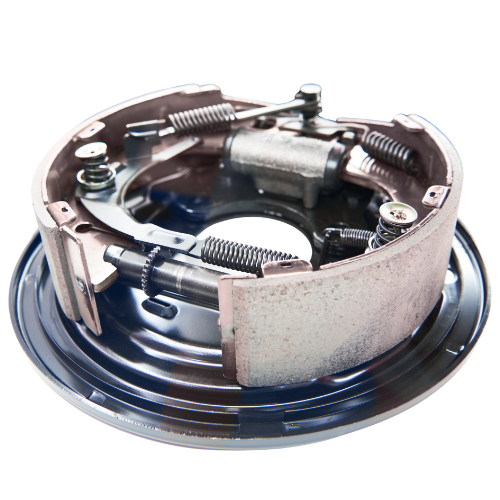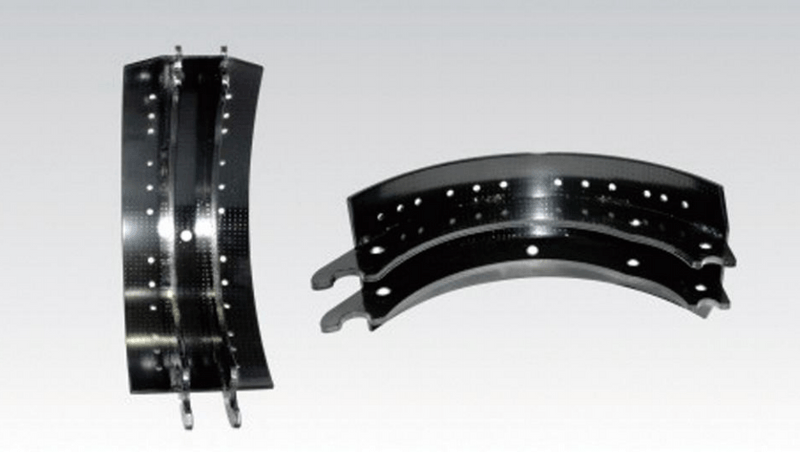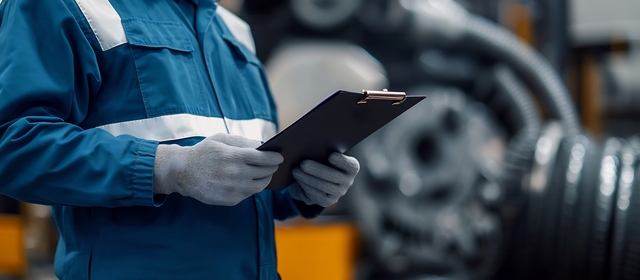Explore the four key components that make up a truck’s brake system—engineered to ensure safe, reliable, and powerful stopping performance on every road.

These curved friction blocks press against the brake drum when activated by air brakes, creating the force needed to stop safely.
Over time, brake shoes wear down due to friction. Replacing them at the right time helps maintain braking efficiency and prevents more costly damage to other parts like brake chambers, slack adjusters, and brake calipers. In this guide, we’ll look at how to recognise when brake shoes should be replaced and what can happen if you wait too long.

Brake shoes are essential components in drum brake systems, especially common in heavy vehicles using air brakes. When the brake pedal is pressed, compressed air activates the brake chamber, pushing the slack adjuster, which in turn pushes the brake shoe outward against the inside of the drum. The resulting friction slows the wheel down.
Unlike brake pads used in disc systems, brake shoes sit inside the drum and rely on the consistent function of supporting parts such as the slack adjuster, brake chamber, and air pressure from the full system.
Here are some common indicators that it may be time to replace the brake shoes on your heavy-duty vehicle:
Most brake shoes have wear indicators or a minimum thickness stamped into the metal. If the lining thickness is close to or below the minimum spec (typically 1/4 inch or 6 mm), it’s time for a replacement.
If you notice longer stopping distances, the shoes might not be creating enough friction. This can also point to uneven wear or contamination like oil or grease on the surface.
Squealing, scraping, or grinding noises when applying brakes could mean the friction material is worn through, allowing metal-to-metal contact.
If the vehicle pulls to one side during braking, it could indicate uneven wear between the left and right brake shoes or a failing slack adjuster.
If manual or automatic slack adjusters require frequent correction, it might be a sign that the brake shoes are excessively worn or not functioning correctly with the brake chamber.

Regular inspection intervals depend on usage, but heavy vehicles typically need brake checks every 20,000 to 30,000 kilometres. In some cases, more frequent inspections may be needed, especially for trucks carrying heavy loads or operating on steep gradients.
Inspections should also include:
Technicians might also look at the health of surrounding parts like the brake chamber, slack adjusters, and brake calipers to ensure the entire system is in sync.
Waiting too long to replace brake shoes can lead to:
Brake shoe lifespan isn’t just about the shoe itself. If other parts of your air brake system are malfunctioning, it can shorten the life of your shoes:
It’s best to look at brake shoes as part of a bigger system — if one part fails, it often affects others.
While all brake shoes wear out eventually, you can help extend their life by:
Knowing when to replace brake shoes is vital for keeping heavy-duty vehicles safe and roadworthy. Regular inspections, attention to braking performance, and an understanding of how the wider system works all contribute to timely, cost-effective maintenance.
By staying alert to early warning signs, and addressing issues before they become serious, you can extend the life of your brake components, reduce downtime, and avoid costly failures. And while replacing brake shoes is part of routine maintenance, it’s also an opportunity to check the health of your entire air brake system, including your brake chambers, slack adjusters, and supporting tools like brake line benders if any work is needed.
How long do brake shoes last in a heavy truck?
This depends on the load, terrain, and driving habits, but a general estimate is 30,000 to 80,000 kilometres. Regular checks are essential.
Can I just replace the brake shoes on one side?
It’s not recommended. Always replace brake shoes in axle pairs to maintain balance and even braking force.
What happens if my brake shoes are worn but I don’t replace them?
You risk damaging the drum, losing braking efficiency, and increasing the wear on related parts like the brake chamber or slack adjuster.
Are there differences in brake shoes between American axle setups and others?
Yes, American axle configurations may use different sizes or fittings. Always match parts based on axle type and manufacturer specifications.
Do worn brake shoes affect air brake pressure?
Not directly, but they can cause the slack adjuster to work harder, which can eventually lead to imbalances or air loss in the system.